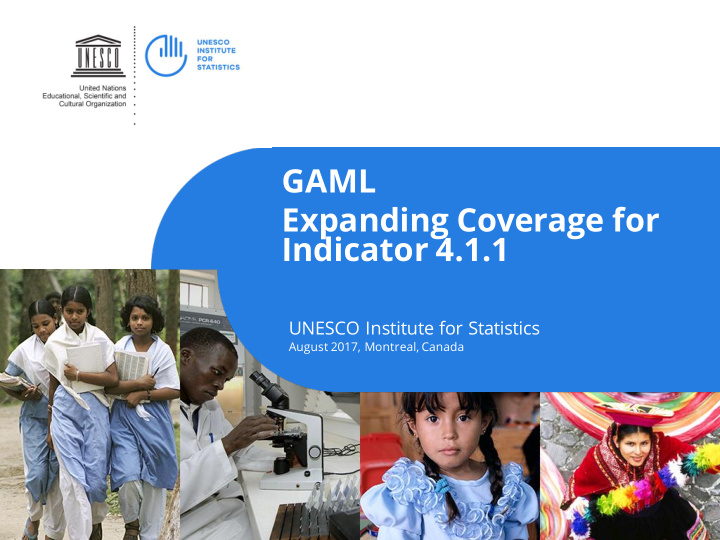



GAML Expanding Coverage for Indicator 4.1.1 UNESCO Institute for Statistics August 2017, Montreal, Canada
2
Expanding Coverage: the problem No global and comparable information exists that can be used to compute SDG 4.1.1. Coverage Issues Many countries do not have data on their children’s and young people’s proficiency levels in reading and mathematics. Technical Issues Among the countries that do have national learning assessments, skills, tools and metrics measure different mathematics and readings skills at different grades/ages. Results are not linked in the same scale Countries have different educational structures National capacity issues Many countries do not have data on their children’s and young people’s proficiency levels in reading and mathematics because they do not have either the financial capacity and/or the technical capacity; The great majority of countries without high-quality learning assessments are either low-income or lower-middle income countries. 3
Expanding Coverage: What do we need? Technical responses through a set of tools to conceptually align assessments: Global Framework for Reference: to define the skills/competencies and contents associated to each point of measurement; Global standards of data alignment for methodological and operational procedures A set of tools and standards to compare and define benchmarks Funding responses though a set of strategies to expand coverage: Funding options to expand coverage of the next round of cross-national learning assessments to expand the number of countries Cross-national assessment expansion to fill the gap for the regions that do not have any regional assessments with special focus given to primary education. Capacity development though a set of strategies to improve data alignment Capacity development strategies (and funding) to support countries to build national learning assessments that meet technical standards. 4
How much will cost? Assumptions Each assessment costs .5 million US dollars Each country does two points each 4 years Parameters 5.8 Billion of US dollar per year as costs for pre-primary through secondary education 10% of inefficiency as conservative number costs US$580 million per year 5% of the inefficiency is addressed with learning data 30 US million per year per country High Benefit Cost ratio ( 30/.25 US million per year -120 million) Funding strategy from international community 100% first year 50% second year O% third year 5
Who will benefit from having the information? 6
Simulating Costs Total number of countries participating Financial support needed, $US millions* 2018-2019 2022-2023 2026-2027 Total Africa 31 31 16 47 LAC 16 16 16 Asia 33 33 17 50 Europe 14 14 14 Oceania 4 4 4 Implementation,all countries 98 31 49 51 130 Coordination 2 2 2 6 Total 33 51 53 136 7
The cost benefit is clearly positive 8
How can we collaborate to make expansion and comparability materialize? 9
Recommend
More recommend